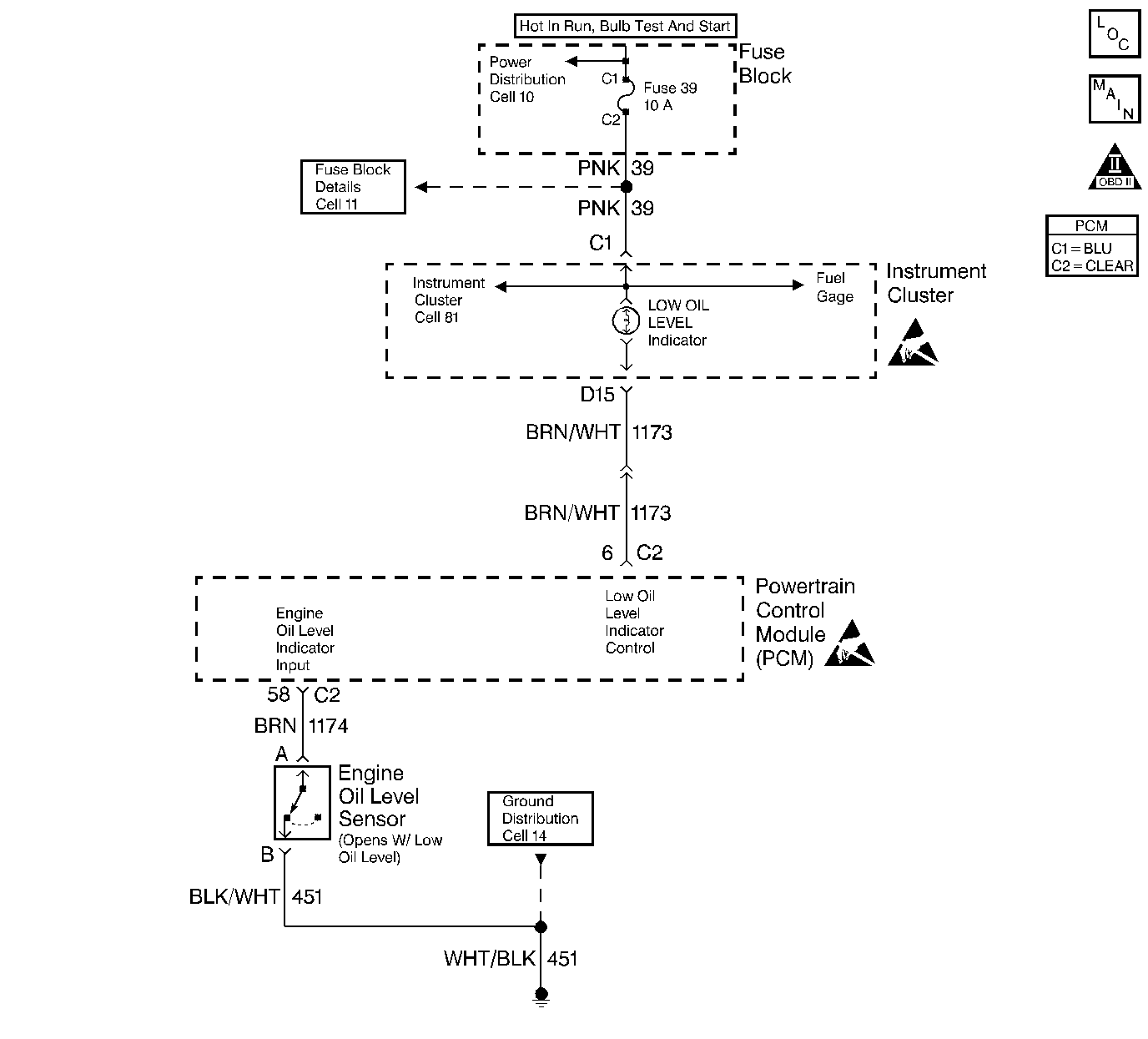
Circuit Description
The Engine Oil Level Switch is a simple float switch that is grounded when the engine oil level is OK. The PCM checks the Engine Oil Level switch circuit at startup. Before checking the state of the Engine Oil Level switch, the PCM performs a test routine based on time and engine coolant temperature to ensure that the engine oil has drained back into the sump. To test for low oil level at start-up, both of the following conditions must be present:
| • | The engine coolant temperature must be greater than 15°C (59°F). |
| • | The engine coolant temperature at key ON must be at least 12°C (22°F) cooler than the engine coolant temperature at the last key OFF. |
Diagnostic Aids
For diagnosis of the instrument panel, perform the System Check in the Instrument Cluster section of Electrical Diagnosis.
Check for the following conditions:
| • | Poor connection at PCM or oil level switch. Inspect harness connectors for backed out terminals, improper mating, broken locks, improperly formed or damaged terminals, and poor terminal to wire connection. Refer to Intermittents and Poor Connections Diagnosis and Connector Repairs and Wiring Repairs . |
| • | Damaged harness. Inspect the wiring harness for damage. If the harness appears to be OK, disconnect the PCM and turn the ignition ON. Observe a voltmeter connected to the affected PCM output circuit while moving connectors and wiring harnesses related to the PCM output circuit. A change in voltage will indicate the location of the fault. Refer to Intermittents and Poor Connections Diagnosis and Connector Repairs and Wiring Repairs . |
Test Description
The numbers below refer to the step numbers on the Diagnostic Table.
-
Normally, ignition feed voltage should be present on the output driver circuit with the PCM disconnected and the ignition turned on.
-
Checks for a shorted component or a short to battery positive voltage on the output driver circuit. Either condition would result in a measured current of over 1.5 amps. Also checks for a component that is going open while being operated, resulting in a measured current of 0 amps.
-
Checks for a faulty instrument cluster.
-
This vehicle is equipped with a PCM which utilizes an Electrically Erasable Programmable Read Only Memory (EEPROM). When the PCM is being replaced, the new PCM must be programmed. Refer to Powertrain Control Module Replacement/Programming .
Step | Action | Values | Yes | No |
|---|---|---|---|---|
1 | Was the Powertrain On Board Diagnostic (OBD) System Check performed? | -- | ||
2 | Was the Instrument Cluster Diagnostic System Check performed? | -- | ||
Is the voltage near the specified value? | B+ | |||
Does the current reading remain between the specified values? | 0.05 amp 1.5 amps | |||
Is voltage at the specified value? | 0.0V | |||
6 | Locate and repair short to voltage in affected PCM output circuit. Is the action complete? | -- | -- | |
7 | Check the ignition feed fuse for the instrument panel cluster indicator lamps. Is the fuse blown? | -- | ||
8 |
Is the action complete? | -- | -- | |
9 |
Is the voltage near the specified value? | B+ | ||
10 |
Was a problem found? | -- | ||
11 |
Was a problem found? | -- | ||
12 |
Does the test light flash on and off? | -- | Go to Diagnostic Aids | |
13 |
Was a problem found? | -- | ||
14 | Locate and repair open in ignition feed circuit to the instrument panel cluster indicator lamps. Refer to Wiring Repairs in Wiring Systems. Is the action complete? | -- | -- | |
15 | Replace the instrument panel cluster. Refer to Instrument Cluster Replacement in Instrument Panel, Gauges, and Console. Is the action complete? | -- | -- | |
|
Important: : The new PCM must be programmed. Replace the PCM. Refer to Powertrain Control Module Replacement/Programming . Is the action complete? | -- | -- | ||
17 | Operate the affected lamp using the scan tool output tests function. Does the affected lamp operate properly? | -- | System OK |
